Bade
Background
 Bade is spoken in the northern part of Yobe State, Nigeria, in an area fanning out east and south of Gashua, the current location of the court of the Emir of Bade (Bedde). It is one of seven languages of the Chadic family indigenous to Yobe State, the others being Bole, Duwai, Karekare, Maka, Ngamo, and Ngizim. Bade is a member of the West Branch of Chadic and is hence related to Hausa, the dominant language throughout northern Nigeria. Bade’s closest linguistic relatives are, however, Ngizim, spoken to the south, around Potiskum, and Duwai, spoken east of Gashua. Bade is dialectally very diverse, to the extent that one could really speak of several “Bade languages”. There are three main dialect varieties: Western Bade, the variety with the largest number of speakers, spoken over the western half to two-thirds of the Bade area, some of the larger Western Bade speaking towns being Amshi, Dagona, Tagali, and, Madamuwa; Southern Bade, spoken to the southeast of the Western area and south of Gashua, with some of the main Southern Bade-speaking towns being Katamma, Katangana, and Gorgoram; and Gashua Bade, spoken in the city of Gashua, by far the largest town in the Bade-speaking area, and villages fanning out around Gashua. There is, moreover, considerable variation within each of these three dialect varieties, with virtually every village having its distinct features. Particulary notable is the town of Karege, more or less at the boundary between the Western and Gashua areas, where the dialect has a unique mix of features from the two dialect varieties. See Schuh (1981) for a description of Bade dialectology.
Bade is spoken in the northern part of Yobe State, Nigeria, in an area fanning out east and south of Gashua, the current location of the court of the Emir of Bade (Bedde). It is one of seven languages of the Chadic family indigenous to Yobe State, the others being Bole, Duwai, Karekare, Maka, Ngamo, and Ngizim. Bade is a member of the West Branch of Chadic and is hence related to Hausa, the dominant language throughout northern Nigeria. Bade’s closest linguistic relatives are, however, Ngizim, spoken to the south, around Potiskum, and Duwai, spoken east of Gashua. Bade is dialectally very diverse, to the extent that one could really speak of several “Bade languages”. There are three main dialect varieties: Western Bade, the variety with the largest number of speakers, spoken over the western half to two-thirds of the Bade area, some of the larger Western Bade speaking towns being Amshi, Dagona, Tagali, and, Madamuwa; Southern Bade, spoken to the southeast of the Western area and south of Gashua, with some of the main Southern Bade-speaking towns being Katamma, Katangana, and Gorgoram; and Gashua Bade, spoken in the city of Gashua, by far the largest town in the Bade-speaking area, and villages fanning out around Gashua. There is, moreover, considerable variation within each of these three dialect varieties, with virtually every village having its distinct features. Particulary notable is the town of Karege, more or less at the boundary between the Western and Gashua areas, where the dialect has a unique mix of features from the two dialect varieties. See Schuh (1981) for a description of Bade dialectology. 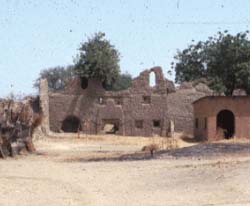 The Ethnologue gives a population figure of 250,000, which seems not unreasonable, since it probably includes all Bade dialects as well as Duwai. The pre-eminent traditional ruler of the Bade people is Mai Bade, whose court is located in now located in Gashua, at the northeastern corner of the Bade region. The traditional capital of Bade Emirate was Gorgoram (go-karam ‘without-chopping’ in Bade, referring to the fact that it was surrounded by dense bush), where is was built as a defense against Kanuri and Fulani predations. The capital moved to the more convenient location of Gashua, on a main road, in the 1920’s. The picture to the left shows the traditional palace in Gorgoram as it appeared in the mid-1970’s. Like all the traditional rulers of northern Nigeria, Mai Bade, in addition to being the political leader, is the premier Islamic authority for the region, the vast majority of whose people are Muslim. A commonly seen spelling for “Bade” dating from the colonial period is “Bedde”, an attempt in English orthography to reflect the vowel pronounced like “uh” in the first syllable. The Bade people pronounce the ethnonym as “Bade” or “Badai“, according to dialect. The origin of the name is uncertain. The table below shows the current autonyms for the people and language in the Western dialect as well as the terms in Hausa and Kanuri, for many centuries the dominant linguistic and cultural force in northeastern Nigeria. (The symbol “@” in the Bade words is a high, central, unrounded vowel, “barred i” in the International Phonetic Alphabet.)
The Ethnologue gives a population figure of 250,000, which seems not unreasonable, since it probably includes all Bade dialects as well as Duwai. The pre-eminent traditional ruler of the Bade people is Mai Bade, whose court is located in now located in Gashua, at the northeastern corner of the Bade region. The traditional capital of Bade Emirate was Gorgoram (go-karam ‘without-chopping’ in Bade, referring to the fact that it was surrounded by dense bush), where is was built as a defense against Kanuri and Fulani predations. The capital moved to the more convenient location of Gashua, on a main road, in the 1920’s. The picture to the left shows the traditional palace in Gorgoram as it appeared in the mid-1970’s. Like all the traditional rulers of northern Nigeria, Mai Bade, in addition to being the political leader, is the premier Islamic authority for the region, the vast majority of whose people are Muslim. A commonly seen spelling for “Bade” dating from the colonial period is “Bedde”, an attempt in English orthography to reflect the vowel pronounced like “uh” in the first syllable. The Bade people pronounce the ethnonym as “Bade” or “Badai“, according to dialect. The origin of the name is uncertain. The table below shows the current autonyms for the people and language in the Western dialect as well as the terms in Hausa and Kanuri, for many centuries the dominant linguistic and cultural force in northeastern Nigeria. (The symbol “@” in the Bade words is a high, central, unrounded vowel, “barred i” in the International Phonetic Alphabet.)
| BADE (Western) | HAUSA | KANURI | |
| People | Baden (m), Badayakon (f) Badewat@n@n (pl) | Babade (m), Babadiya (f) Badawa (pl) | Bade |
| Language | Gabaden | Badanci | Bade |
Research on Bade
Several people have published work on the Bade language. Wordlists of Bade date to the mid-19th century in Sigismund Koelle’s Polyglotta Africana. The first work on Bade informed by modern linguistic standards was that of Johannes Lukas, done in the 1950’s and 1960’s. Both Lukas and his daughter, Renate, published descriptive works and collections of texts. Russell G. Schuh did extensive work on Bade in the mid-1970’s, resulting in several descriptive publications and collections of texts in Bade. Click the link “Papers on Bade” at the left to access downloadable versions of mose of these papers. Most of the material on this website derives from the Yobe Language Research project, funded by two grants from the US National Science Foundation: “The Chadic Languages of Yobe State, Nigeria”, 2001-2004 (award #BCS-0111289, Russell G. Schuh, Principal Investigator), and “Lexicon, Linguistic Structure, and Verbal Arts in Chadic Languages of Northeastern Nigeria”, 2006-2009 (award #BCS-0553222, Russell G. Schuh, Principal Investigator). Directors of both projects have been Russell G. Schuh and Alhaji Maina Gimba. Members of the Bade team are Bala Wakili Dagona, a speaker of the Western dialect, and Mukhtar Musa Tarbutu, a speaker of Gashua Bade. Work during the first NSF grant period included both Western and Gashua varieties of Bade, but because of limited time and resources, the second project is focusing on the Western variety. Thanks go to the late Mai Bade, HRH Alhaji Saleh ibn Suleiman, and the current Mai Bade, HRH Abubakar Umar Sulaiman for their support. Madu Liman and his family provided indispensable logistic support.
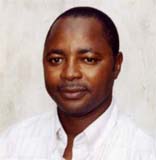
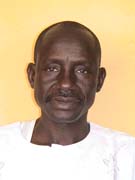

Greetings
 The two videos below are examples of typical Bade greeting sequences. They were taped in Dogona, Yobe State in July 2004. Dagona is in the Western dialect area. Here is a transcript and explanation of the greetings videos.
The two videos below are examples of typical Bade greeting sequences. They were taped in Dogona, Yobe State in July 2004. Dagona is in the Western dialect area. Here is a transcript and explanation of the greetings videos.
Bade Verbal Arts
The term “verbal arts” encompasses all forms of verbal expression, including story-telling, proverbs, riddles, tongue-twisters, and songs. Documentation of verbal arts in Bade come from two research periods: research in 1973-1975, supported by the Centre for the Study of Nigerian Languages (Paul Newman, Director), at that time a unit of Ahmadu Bello University, Zaria and now a unit of Bayero University Kano; research in 2002-2009, supported by two US National Science Foundation grants (see the Yobe Languages Research Project home page for details). This page presents documentation of “prose” verbal arts (song is on a separate page). More will be added to this page as it is prepared for internet delivery. Documentation is from three dialects: Western, Gashua, and Southern, though available documentation of the former is by far the most extensive.
- Terzenan’ Amsi [Tales from Amshi], and other tales from Amshi (1974)
- Mimin’ Yin [Tales from Yim], and other tales from Yim (1974)
- Tentemen’ Ad’o [Tales from the South] (1975)
- Terzenako, Mimiko, Temtemeko de Makaranta Gasiwa [“Here’s a Tale” from Gashua (Secondary) School] (1975, 2004)
- Traditional customs of marriage and birth (2002)
- Terzena Gabade [Tales in Bade] (2003)
- Erwan Gabade [Bade Songs] (2009)
- Tales from Adiya, Sugum, and Tagali (1974)
- Unpublished texts in Gashua Bade (1973-75)
NOTE ON DOWNLOADABLE DOCUMENTS: The first four items are PDF scans of the originals, with the text converted by OCR recognition. The appearance of the text is as in the original. The OCR recognition allows for searches and copy and paste of text into other documents, but because the graphic quality of the original text is far from perfect (having been reproduced in 1975 from Gestetner stencils in a remote Nigerian town with no modern amenities) and because the text contains symbols not found in the standard Roman alphabet, searches are not completely reliable and text pasted into other documents requires considerable editing to restore the original written form.
Terzenan’ Amsi [Tales from Amshi]
Terzenan’ Amsi was published in 1974 in Gashua, Nigeria by the Center for the Study of Nigerian Languages. It is a collection of eight folktales in a variety of the Western dialect of Bade, narrated by people from the village of Amshi. Some were recorded during trips to Amshi, some were recorded in Gashua by the late Musa Gana Amshi, who was my main collaborator on Bade in Gashua. Musa accompanied me on many trips to villages, where he made arrangements for us to stay, assembled story-tellers, and the like, and he worked with me on the tedious job of transcribing hours of Bade recordings. The Bade text is a PDF scan of the full original book. The translations of the stories are individual documents. MP3 files of the recordings of all these tales are available on request from schuh@humnet.ucla.edu. Full Bade text of Terzenan’ Amshi English translations of individual tales
- A Hyena and a Monitor (Amadu Amshi)
- A Crowned Crane and a Squirrel (Maina Karva)–include Bade text with interlinear gloss
- A Jackal and a Hyena (Maina Karva)
- A Man and a Cattle Egret (Musa Gana)
- A Squirrel and a Cattle Egret (Musa Gana)
- A Squirrel and a Buffalo (Musa Gana)
- A Jackal and a Heron (Musa Gana)
- A Hyena and a Shepherd (Musa Gana)
Mimin’ Yin [Tales from Yim]
 Mimin’ Yin was published in 1974 in Gashua, Nigeria by the Center for the Study of Nigerian Languages. It is a collection of ten folktales in a variety of the Western dialect of Bade, narrated by people from the village of Yim. Some of the tales were recorded in Yim town. Those narrated by Jiji Musa Yin were recorded in Gashua. Jiji was the wife of the late Musa Gana Amshi (see above). The Yin and Amshi dialects are quite similar, and Musa helped in transcribing the Yin tales. The Bade text is a PDF scan of the original book. The translations of the stories are individual documents. Full Bade text of Mimin’ Yin English translations of individual tales
Mimin’ Yin was published in 1974 in Gashua, Nigeria by the Center for the Study of Nigerian Languages. It is a collection of ten folktales in a variety of the Western dialect of Bade, narrated by people from the village of Yim. Some of the tales were recorded in Yim town. Those narrated by Jiji Musa Yin were recorded in Gashua. Jiji was the wife of the late Musa Gana Amshi (see above). The Yin and Amshi dialects are quite similar, and Musa helped in transcribing the Yin tales. The Bade text is a PDF scan of the original book. The translations of the stories are individual documents. Full Bade text of Mimin’ Yin English translations of individual tales
- A Squirrel and a Guinea Fowl (Musa Gana Yin)
- A Squirrel and a Hornbill (Musa Gana Yin)
- Some Children and a Chameleon (Sauba Musa Yin)
- Three Men (Dala Kintapo)
- A Girl and the Ear Monster (Jiji Musa Yin)
- The Story of Jlawi and Gaji (Jiji Musa Yin)
- A Monkey and a Hare (Jiji Musa Yin)
- Bamdimarem and a Hyena (Jiji Musa Yin)
- Two Women and a Kuliram (Jiji Musa Yin)
- A Squirrel and His Three Wives (Jiji Musa Yin)
Other tales from Yim: here are further tales told by storytellers from Yim, not previously available in printed form Mabaran den’ Amari [A Hunter and His Wife], narrated by Jiji Musa Yim in July 1974, recorded by Musa Gana Amshi. A hunter catches a bird, and despite its pleas, kills, cooks, and eats it.
Tentemen’ Ad’o [Tales from the South]
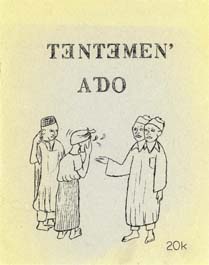 Tentemen’ Ad’o was published in 1975 in Gashua, Nigeria by the Center for the Study of Nigerian Languages. It is a collection of seven folktales in the Southern Dialect of Bade, narrated by speakers from the towns of Katamma and Katangana. The tales were recorded during visits to those towns and were transcribed with the help of Ad’abzeki Katangana. The Bade text is a PDF scan of the original book. The translations of the stories are individual documents. MP3 files of the recordings of all these tales are available. Full text of Tentemen’ Ad’o English translations of individual tales
Tentemen’ Ad’o was published in 1975 in Gashua, Nigeria by the Center for the Study of Nigerian Languages. It is a collection of seven folktales in the Southern Dialect of Bade, narrated by speakers from the towns of Katamma and Katangana. The tales were recorded during visits to those towns and were transcribed with the help of Ad’abzeki Katangana. The Bade text is a PDF scan of the original book. The translations of the stories are individual documents. MP3 files of the recordings of all these tales are available. Full text of Tentemen’ Ad’o English translations of individual tales
- The Story of Multi-head (Kaugdek Babayi, Katamma)
- A Story of a Squirrel and a Hyena (Amina Gishuwa, Katamma)
- The Story of Kayikdakami (Musa Kavayo dek Beltu Wunini, Katangana)
- The Story of the Communal Labor that was Imposed on the Squirrel (Musa Kavayo dek Beltu Wunini, Katangana)
- The Story of Biyamami (Kabajlu Musa, Katangana)
- The Story of a Girl and her People (Zaziya Belabade, Katangana)
- The Story of a Hyena and a Shepherd (Ayuba Musa, Katangana)
Terzenako Mimiko Temtemeko de Makaranta Gasiwa [“Here’s a Tale” from Gashua School]
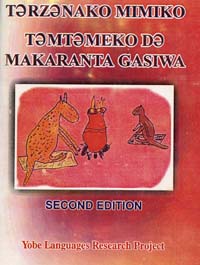 Terzenako Mimiko Temtemeko de Makaranta Gasiwa is a collection of 58 folktales as well as proverbs and riddles from all over Bade Emirate. It was originally published in 1975 in Gashua by the Centre for the Study of Nigerian languages are reprinted in 2004 by the Yobe Languages Research Project. The cover to the left is from the reprint. The stories, proverbs, and riddles in this book were written by students at Government Secondary School, Gashua in 1975. Illustrations are all by the students as well. The orthography was regularized by Russell Schuh, and the text was reproduced from Gestetner mimeograph stencils. The stories, proverbs, and riddles were written by 36 different students from 16 different villages. The language represents many sub-varieties of both the Western and Gashua dialects of Bade, and one tale and some proverbs are in Duwai, a closely related by mutually unintelligible language (there are no stories from the Southern dialect of Bade). This collection is comparable to the Kinder- und Hausmärchen compiled by the brothers Grimm in terms of the range of folklore and dialects represented. Because of its special importance, it deserved reprinting in 2004 for the enjoyment of a new generation of Bade speakers, some of whom are children of the original contributors! Full Bade text of Terzenako Mimiko Temtemeko de Makaranta Gasiwa English translation (because of the large number of tales, the translation of the entire book is in one document, with pagination of the translations the same as for the original Bade; only a few tales are so far translated–new tales will be added as time permits)
Terzenako Mimiko Temtemeko de Makaranta Gasiwa is a collection of 58 folktales as well as proverbs and riddles from all over Bade Emirate. It was originally published in 1975 in Gashua by the Centre for the Study of Nigerian languages are reprinted in 2004 by the Yobe Languages Research Project. The cover to the left is from the reprint. The stories, proverbs, and riddles in this book were written by students at Government Secondary School, Gashua in 1975. Illustrations are all by the students as well. The orthography was regularized by Russell Schuh, and the text was reproduced from Gestetner mimeograph stencils. The stories, proverbs, and riddles were written by 36 different students from 16 different villages. The language represents many sub-varieties of both the Western and Gashua dialects of Bade, and one tale and some proverbs are in Duwai, a closely related by mutually unintelligible language (there are no stories from the Southern dialect of Bade). This collection is comparable to the Kinder- und Hausmärchen compiled by the brothers Grimm in terms of the range of folklore and dialects represented. Because of its special importance, it deserved reprinting in 2004 for the enjoyment of a new generation of Bade speakers, some of whom are children of the original contributors! Full Bade text of Terzenako Mimiko Temtemeko de Makaranta Gasiwa English translation (because of the large number of tales, the translation of the entire book is in one document, with pagination of the translations the same as for the original Bade; only a few tales are so far translated–new tales will be added as time permits)
Traditional Marriage and Birth Customs
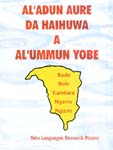 These are texts from Al’adun Aure da Haihuwa a Al’ummun Yobe [Hausa: Customs of Marriage and Birth among Yobe Peoples], a collection published in Potiskum in 2002 by the Yobe Languages Research Project. The collection comprises descriptions of marriage and birth practices among five Yobe groups: Bade, Bole, Karekare, Ngamo, and Ngizim. Click on the links below for the Bade texts with line by line English translation. Patlak Bade Kak Ca [Traditional Bade Marriage Customs] Estang Md’ek Bade Kak Daten [Traditional Bade Naming Ceremony]
These are texts from Al’adun Aure da Haihuwa a Al’ummun Yobe [Hausa: Customs of Marriage and Birth among Yobe Peoples], a collection published in Potiskum in 2002 by the Yobe Languages Research Project. The collection comprises descriptions of marriage and birth practices among five Yobe groups: Bade, Bole, Karekare, Ngamo, and Ngizim. Click on the links below for the Bade texts with line by line English translation. Patlak Bade Kak Ca [Traditional Bade Marriage Customs] Estang Md’ek Bade Kak Daten [Traditional Bade Naming Ceremony]
Terzena Gabade [Tales in Bade]
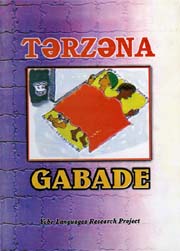 Terzena Gabade [Tales in the Bade Language] is a collection of twelve traditional tales transcribed from recordings by several Bade storytellers. There are six stories in the Gashua dialect and six in the Western dialect. This collection was published in 2003 by the Yobe Languages Research Project (printed by Ajami Press, Potiskum). The tales can be downloaded in pdf format by clicking on the links below. The files are formatted line by line with Bade side by side with rough English translations.
Terzena Gabade [Tales in the Bade Language] is a collection of twelve traditional tales transcribed from recordings by several Bade storytellers. There are six stories in the Gashua dialect and six in the Western dialect. This collection was published in 2003 by the Yobe Languages Research Project (printed by Ajami Press, Potiskum). The tales can be downloaded in pdf format by clicking on the links below. The files are formatted line by line with Bade side by side with rough English translations.
Gashua Dialect
Terzena Wunya dek Ebjlem [Tale of the Girl and the Hyena]: A girl marries a hyena. When her mother comes to visit, the “husband” plots to eat his mother-in-law, but he is foiled. (See a parallel story in the Western dialect, below.) Simanak Waziri deng Mayi [A Story of a Vizier and a King]: Because of the meddling of an old woman, the beautiful wife of a Vizier leaves her husband to marry a king, but the Vizier has the last word Terzenak Ndi dek Amateli [Tale of a Man and His Wife]: The secret name of a man is revealed to his wives, with consequences for all. Terzenak Degem dek Tariza [Tale of a King and Tariza]: The bird Tariza distracts the children of a king sent to collect thatch grass, then the king himself, but the situation alters when he brings Tariza home, things take a different turn. Terzena Kaza, Temaku dek Ebjlem [Tale of a Hen, a Sheep and a Hyena]: A hen and a sheep run away with their children to avoid their being sacrificed, but they make the mistake of joining forces with a hyena. Terzenak Ebjlem dek Fida [Tale of a Hyena and a Hare]: A hyena pursues a hare to eat him, but as usual the hyena is outsmarted.
Western Dialect
Makid’an’ Mdan Kid’e Metkeri [The Eater of People Eats His Mother]: A girl marries a sorcerer who eats people. When her mother comes to visit, the husband plots to eat his mother-in-law, but he is foiled. (See a parallel story in the Gashua dialect, above.) Nebapata [Nebapata (“I Found Her in the Bush”)]: A girl, miscarried by her mother, is found by an ogre and raised by him, but then is found by her brothers. (An unusual story–one of my favorite from Yobe State.) Terkawaten [Orphans]: Two girls whose mother have died are mistreated by their wicked stepmother, but the tables are turned in the end. Amangunen Seren [Two Co-wives]: A neglected co-wife is befriended by a spirit. When her co-wife tries to follow her path, things take a turn for the worse. But then…the story ends in an unpredicted way–strange to say the least. Wuneng Amangwan [A Son of a Co-wife]: A woman wants to get rid of the son of her co-wife so that her husband will devote more attention to HER children. Squirrel and hyena to the rescue! Amangwan [A Co-wife]: A jealous co-wife substitutes a grindstone for her co-wife’s son.
Erwan Gabade [Songs in Bade]
 This is a collection of traditional women’s songs, some recorded and transcribed in Bade villages in the mid-1970’s, some videotaped and transcribed in Dagona in January 2009. Click here or on the image to download a PDF file of the text with English translation. The songs in the text are grouped more or less in terms of theme. For an outsider, the content seems extremely allusive, disconnected, and hard to understand. For lack of time and resources, it was not possible to get much in the way of interpretation or explanation from the people who could give an authoritative account, viz. the women who sang the songs. Making the songs available is a start. The real work lies ahead! A CD with audio recordings of all the songs can obtained from schuh@humnet.ucla.edu for $5.00 US, €5.00, £5.00 UK to cover materials and mailing. You may order through PayPal. Use your existing account or create an account to transfer payment to schuh@humnet.ucla.edu. The contents are as follows: ERWAN ANGARIN [Songs of Innuendo]: These are women’s songs, typically sung during work such as grinding or pounding. They usually have to do with relations with men and with other women and often contain veiled insults about women competing for the same man, scorn by a man, and the like.
This is a collection of traditional women’s songs, some recorded and transcribed in Bade villages in the mid-1970’s, some videotaped and transcribed in Dagona in January 2009. Click here or on the image to download a PDF file of the text with English translation. The songs in the text are grouped more or less in terms of theme. For an outsider, the content seems extremely allusive, disconnected, and hard to understand. For lack of time and resources, it was not possible to get much in the way of interpretation or explanation from the people who could give an authoritative account, viz. the women who sang the songs. Making the songs available is a start. The real work lies ahead! A CD with audio recordings of all the songs can obtained from schuh@humnet.ucla.edu for $5.00 US, €5.00, £5.00 UK to cover materials and mailing. You may order through PayPal. Use your existing account or create an account to transfer payment to schuh@humnet.ucla.edu. The contents are as follows: ERWAN ANGARIN [Songs of Innuendo]: These are women’s songs, typically sung during work such as grinding or pounding. They usually have to do with relations with men and with other women and often contain veiled insults about women competing for the same man, scorn by a man, and the like.
- Yaware (1, Dakona)
- Yaware (2, Dakona)
- Yaware (3, Dakona)
- Yaware (1, Sugum)
- Yaware (2, Sugum)
The term Yaware is taken from a meaningless word used in the refrain and often as a line introducer in these songs. What the songs have in common is form and theme. In form, there is a solo singer and a chorus. A “verse” consists of two or three lines by the soloist, followed by the chorus, which usually consists of two lines, part or all of which will comprise a meaningless string of syllables (yaware yayyeraye, or the like) and a repetition of the last line that the soloist sang. The theme is (always?) human relations, usually love and rivalry for lovers among men and women. The collection here contains three such songs from the village of Dagona/Dakona and two from Sugum. Zayan (Dakona): Zayan is generally a funeral lament, but the version here is thematically a song of innuendo. Arororororo (Ad’iya): The “title” is, like Yaware above, a series of meaningless syllables to set the rhythm of the song. The theme is like those above. Only one version, from the village of Ad’iya, was available, but like Yaware, this is probably a general form and theme into which many songs could fit. ERWAN’ UKTAN’ AD’AN [Songs of Praise, literally “Taking Head”]: These could probably be sung in any context and could probably song by either women or men. The first here is thematically similar to the songs above, but it includes implicit praise of a number of prominent individuals. The second is sung at an annual festival and mentions the District Head of Dagona, among others. Na Ne Dakona (Dakona) [I Am Going to Dagona] Dalilek Zarya (Dakona) [Festival of the Fish Dam] ERWAN YARON’ AMATEN [Girls’ Songs]: These are songs generally sung by girls for dances and games. The form is always a soloist and a chorus that repeats a short refrain (the “name” of the song in each of the cases here) after each line sung by the soloist. The content is typically nonsensical or fantasy. Some include scatalogical lines that elicit laughs from the audience.
- Yayibalu (Dakona)
- Yayibalu (Amshi)
- Yayibalu (Tagali)
- Yayibalu (Tagali)
- Yallabe (Dakona)
- Yallabe (Amshi)
- Nayibe (Dakona)
- D’isi (Amshi)
Tales from Adiya, Sugum, and Tagali
 The texts here were recorded and transcribed in 1973-1975 but have never appeared in printed form anywhere. These towns are all in the “Far Western” dialect, where, among other features, voicing dissimilation of clitics is an active process. Download PDF files with English translation by clicking on the links. (Picture taken by Russell Schuh in Dagona, January 12, 2009)
The texts here were recorded and transcribed in 1973-1975 but have never appeared in printed form anywhere. These towns are all in the “Far Western” dialect, where, among other features, voicing dissimilation of clitics is an active process. Download PDF files with English translation by clicking on the links. (Picture taken by Russell Schuh in Dagona, January 12, 2009)
Tales from Adiya
Forthcoming
Tales from Sugum
Kayan d’en’ Amateri [A Squirrel and his Wives], narrated by Keratu Wunyan’ Idi, recorded by Russell G. Schuh in Sugum, March 23, 1974
Tales from Tagali
Forthcoming
Unpublished Texts in Gashua Bade
 The texts here were recorded and transcribed in 1973-1975 but have never appeared in printed form anywhere. Download PDF files with English translation by clicking on the links. (Picture taken by Russell Schuh in Katuzu, July 24, 2004) Bamzemek Duwa [Bamzamu of the River], narrated by Muhammadu Mai Gari on May 11, 1974, recorded by Russell G. Schuh: The girls of the town, along with the king’s daughter, go to pick ebony fruits, leaving their water jugs at the river’s edge. Bamzamu of the River steals the jugs as a ruse to entrap the king’s daughter. How will she be rescued? Magana dek Wunyatkela [An Herbalist and Her Daughter], narrated by Muhammadu Mai Gari on May 11, 1974 in Gashua, recorded by Russell G. Schuh: An herbalist gives her daughter in marriage to a hyena as a way to assure herself a supply of meat. One day, however, the hyena fails to get meat and decides to eat his mother-in-law instead. (See another version of the same story in Gashua Bade; see a of pretty much the same story in Western Bade.) The three texts below don’t make a lot of sense. They were narrated by Wunya Gana User in the town of User on March 17, 1974, recorded by Russell G. Schuh. The prose consists of snatches of more elaborate stories collected elsewhere by other story tellers. The narrations really just provide a context for songs, which the narrator sings with gusto and which are appreciated by the audience, judging by interspersed ululations. The sound files are included, since without these, the stories don’t mean much.
The texts here were recorded and transcribed in 1973-1975 but have never appeared in printed form anywhere. Download PDF files with English translation by clicking on the links. (Picture taken by Russell Schuh in Katuzu, July 24, 2004) Bamzemek Duwa [Bamzamu of the River], narrated by Muhammadu Mai Gari on May 11, 1974, recorded by Russell G. Schuh: The girls of the town, along with the king’s daughter, go to pick ebony fruits, leaving their water jugs at the river’s edge. Bamzamu of the River steals the jugs as a ruse to entrap the king’s daughter. How will she be rescued? Magana dek Wunyatkela [An Herbalist and Her Daughter], narrated by Muhammadu Mai Gari on May 11, 1974 in Gashua, recorded by Russell G. Schuh: An herbalist gives her daughter in marriage to a hyena as a way to assure herself a supply of meat. One day, however, the hyena fails to get meat and decides to eat his mother-in-law instead. (See another version of the same story in Gashua Bade; see a of pretty much the same story in Western Bade.) The three texts below don’t make a lot of sense. They were narrated by Wunya Gana User in the town of User on March 17, 1974, recorded by Russell G. Schuh. The prose consists of snatches of more elaborate stories collected elsewhere by other story tellers. The narrations really just provide a context for songs, which the narrator sings with gusto and which are appreciated by the audience, judging by interspersed ululations. The sound files are included, since without these, the stories don’t mean much.
- Wunya Gad’i (1) [A Certain Girl (1)]: A boy refuses to give a girl water unless she calls his name.
- Wunya Gad’i (2) [A Certain Girl (2)]: A crane marries a girl and insists that they walk to his hometown.
- Manyim Gad’i [A Certain Boy]: Basically the same theme as “Wunya Gad’i (1)” above.
The following four texts are pdf scans of typescripts prepared as camera-ready copy for potential publication, but which never appeared in print. They have interlinear morpheme-by-morpheme glosses and a free English translation.
- Sammana Katuzu [History of Katuzu], interview of Maina Aziya Katuzu by Kacalla Buba in February 1974 in Katuzu: An oral history of the Bades, focusing on Katuzu (a village near Gashua) and the eastern area of Bade country.
- Talu dek Amali [A Pelican and His Wife], narrated on December 20, 1973 by Manasi Katuzu: A favorite tale in this area, in which a character (in this case a pelican, but it differs from teller to teller) invites various animals who dislike each other to a communal labor gathering as a ruse to achieve a goal.
- Wunya dek Amak Afu [The Daughter and the Father’s Other Wife], narrated on December 20, 1973 by Manasi Katuzu: A girl is trapped in a hollow baobab by her scheming stepmother, and a contest ensues to free her.
- Kangegi dek D’isu [The Chameleon and the Red-Cheeked Cordon-Bleu], narrated on December 20, 1973 by Manasi Katuzu: The cordon-bleu is married to the lazy chameleon, and she punishes him for his laziness.
Bade Language Demonstrations
The movie below illustrates two tone spreading processes in Bade. Both speakers are from Dagona and speak a Western variety of Bade. bade_tone_spreading.mov
Descriptive Papers on Bade
Items on this page describe features of Bade linguistic structure. Most of the descriptive works are on the Western dialect, particularly that of Amshi and other villages in the “central” part of the Western Bade-speaking area. “Western Bade Phonology.” Manuscript, UCLA. no date (late 1970’s).
A description of the phonology of Western Bade, originally intended as a chapter in a reference grammar that was never written (at least not yet!).
“Western Bade verbal morphology.” Manuscript, UCLA. no date (late 1970’s).
A description of the verbal morphology of Western Bade, originally intended as a chapter in a reference grammar that was never written (at least not yet!).
“Western Bade nominal morphology.” Manuscript, UCLA. no date (late 1970’s).
A description of the nominal morphology of Western Bade, originally intended as a chapter in a reference grammar that was never written (at least not yet!).
“Using dialect geography to determine prehistory: a Chadic case study.” Sprache und Geschichte in Afrika 3:201-250, 1981.
Bade falls into three major dialect areas. The dialects differ by what Russell G. Schuh refers to as isophones and isomorphs (area of shared phonological and morphological innovations respectively). There is some “leakage” along dialect boundaries, but innovations tend to form bundles that define areas, with the exception of one town, Karege, which seems to have random mix of features from its neighbors.
“Voicing dissimilation in Western Bade.” 2002. Ms, UCLA
This paper was written as a sample paper for a UCLA introductory class in phonology, but it is an original piece of research. Schuh (1997) documents a sound change by which voiced obstruents in Bade become voiceless if the next syllable begins in a voiced obstruent. In the far-western part of the Western Bade dialect area (in towns such as Tagali, Sugum, Adiya, and Madamuwa), this sound change remains an active phonological process whereby clitics and prefixes alternate in voicing of their consonant depending on the phonology of their hosts.
“Bade morphology.” In Alan S. Kaye (ed.), Morphologies of Africa and Asia, Volume 1, pp. 587-639. Winona Lake, Indiana: Eisenbrauns, 2007.
This is a descriptive paper of the inflectional and derivational morphology of the western variety of Bade, a West Chadic-B language. Notable features are an active grammatical gender system, citation of nouns with an erstwhile determiner (referred to as “nunation”), which is omitted in a variety of environments, productive processes of participial adjective and agentive derivation from verbs, and morphology on many verbs that shows transitive or intranstive use. This downloadable version is the original manuscript and differs from the published from in have a more comprehensive description of the phonology and more examples of some of the morphological patterns.
Papers with Significant Descriptive Portions on Bade Together with Ngizim
In Winter Quarter 2002, Prof. Russell G. Schuh gave a graduate proseminar at UCLA on the phonology and morphology of the Bade and Ngizim languages, base on data collected prior to the Yobe Languages Research Project. As part of this project Russell G. Schuh prepared extensive descriptive handouts that and posted on a course website as pdf files. In addition to descriptions of phonology and morphology, there is a bibliography and a couple of papers on historical phonology. Click here to see the course website and links to handouts and papers.
“Bode, Ngo:djin and Do:ai in the Polyglotta Africana.” African Languages/Langues africaines 1:290-299.
Exegesis of wordlists in Koelle’s Polygotta Africana for Bade, Ngizim, and Duwai.
“Bade/Ngizim determiner system.” Afroasiatic Linguistics 4(3):101-174, 1977.
A complete description of determiners in three dialects of Bade, Ngizim and Duwai. The description includes marking for definiteness/indefiniteness, demonstratives, presentatives, and genitive phrases.
“Bade/Ngizim vowels and syllable structure.” Studies in African Linguistics 9:247-283, 1978.
A description of distribution of vowels, particular schwa, whose presence is determined by syllabic exigencies and whose quality is determined by consonantal environment. The paper shows how, historically, Bade (all dialects) has shifted from an earlier stage, represented by Ngizim, where word initial CC require schwa between the consonants, to the modern Bade stage, where consonants form sequences if they can and the schwa is prothetic.
“Changes in obstruent voicing in Bade/Ngizim.” 1997. Ms, UCLA
This paper was written as a sample paper for a UCLA introductory class in historical linguistics, but it is an original piece of research. In Ngizim, when a word begins in an obstruent and the next syllable begins in a voiced obstruent, the first obstruent has become voiced if it was voiceless. In Bade, on the other hand, if the second syllable begins in a voiced obstruent, the first obstruent has become devoiced if it was voiceless.
“The Linguistic Influence of Kanuri on Bade and Ngizim”. Maiduguri Journal of Linguistic and Literary Studies (MAJOLLS), 5:55-89, 2003
Kanuri has had considerable linguistic influence on Bade and Ngizim for several centuries. Kanuri loanwords in Bade and Ngizim preserve phonological properties that Kanuri itself has change in more recent times. On the other hand, Bade and Ngizim have altered Kanuri words phonologically and morphologically in order to integrate them into the native system. (abstract of the paper)


